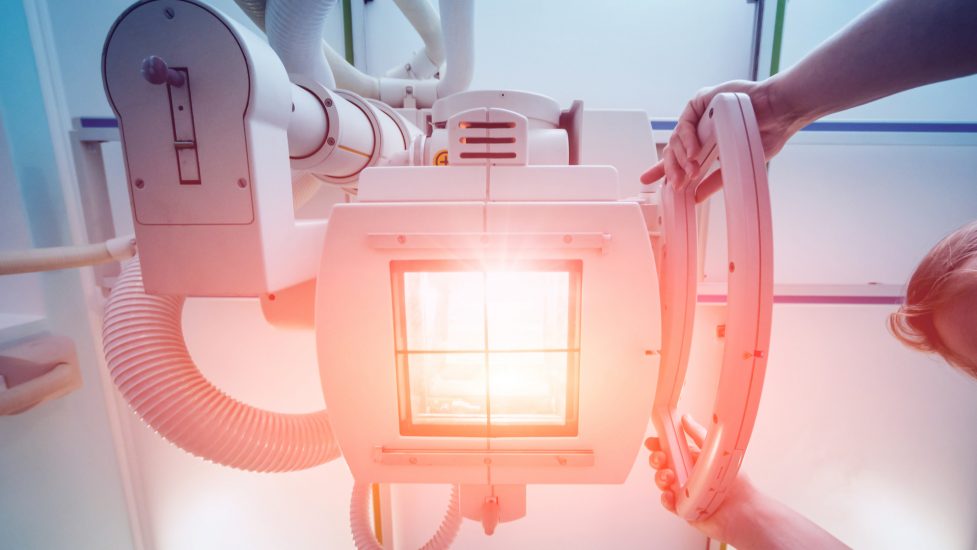As a working mom, attending career-building classes outside of work does not fit well into Kandyce Ashlock’s life.
Based in Las Vegas, Ashlock works at CareNow Urgent Care, an integrated line of business for HCA Healthcare. A partnership between her employer and The College of Health Care Professions (CHCP) in Texas is affording the medical assistant the opportunity to take a step up in her career by training online—and while at work—to become a limited medical radiography technologist (LMRT).
“We are taking on that burden of paying for their tuition to help them realize those goals and for them to move on to future paths,” explains Jami Rimer, market manager for CareNow Urgent Care. “This program was designed to really keep our frontline workers working. It offers them the flexibility to be able to do that didactic training online. They don’t have to attend a brick and mortar [school].”

Ashlock is part of the program’s first cohort with students in both Las Vegas and Houston. “Most of us are moms, so it definitely appealed to all of us. We actually all talked about it. We were like, ‘This is actually really flexible with our schedules.’ Being a mom working, being a wife, everything like that.”
“I have a two-year-old, so it’s very flexible. Being able to do the training on the job is actually really great. So that avoids the whole traveling. I work three 13-hour shifts and then I am off four days. So, that makes it more easy to get everything done.”
Rimer explains the motivation to help employees advance, “We have a motto that is, ‘Care like family,’ so that not only extends to the care that we provide our patients, but it also extends to our frontline workers and those that we are charged to develop in their professional career.”
“When our employees are experiencing such a high level of satisfaction within their growth, it translates into excellent patient care,” she adds.
Six Months to a Certification
The six-month training is a combination of online learning and hands-on practicum within the urgent care and hospital facilities. “For the first month, they’re really learning core curriculum with principles of radiography, how to position patients,” explains Rimer.

“Once they have that baseline understanding, they work very closely with that preceptor [experienced practitioner] over a period of six weeks. Once that six-week period has ended, the rest of their time—while they’re working simultaneously with the didactic trainer on the online courses—they’re also working with LMRTs within the market to exercise the 180 hours that they need to become proficient in this profession.”
“The LMRT certification is valid through the American Registry of Radiologic Technologists (ARRT). They test for that certification in order to hold a state licensure for them to produce x-rays within our clinics,” says Rimer.
She notes, “In most states, [the certification] will transfer. If the student elects to move to another state, they would show that they’ve already tested for that competency and have the educational requirements for that competency. And [the state] would recognize that and award them a state license in that state.”
Become a Limited Medical Radiologic Technologist | CHCP
Limited Medical Radiologic Technologists, also referred to as limited X-ray technologists or medical imaging technologists, take X-rays of patients’ various anatomy, then pass the images along to doctors for diagnosis. The limited X-ray technologist role is very specialized, yet you will still work closely with patients, explaining procedures, setting up and operating the X-ray machine and related equipment.
While the soon-to-graduate cohort is based in Las Vegas and Houston, Rimer says training is being made available to CareNow employees in Austin and Nashville. Expansion to California, Florida, and South Carolina is also part of the plan.
“CHCP has dedicated four cohorts of 20 students apiece to go through a 12-month period with us,” says Rimer. “We hope to have coast to coast participation by the end of the year. So, looking into 2022, we would have a full-scale participation.”
In 2020, the median annual pay for a medical assistant was $35,850, according to the Bureau of Labor Statistics (BLS).
This compares to median pay of $63,710 per year for radiologic and MRI technologists. The projected job growth for this occupation – for the 10 years ending in 2029 – is 16,800.
Broader Roles for Allied Health Professionals
“It is very powerful to see [HCA Healthcare] investing in their people versus going outside and trying to hire. From a quality of care, it is huge. From a return on investment, it’s huge,” says Eric Bing, chancellor and CEO of CHCP. “[The employers] know where they have the gaps. So, the reason they’re investing to cross-train is to fill those gaps.”
With CHCP being the largest provider of allied health graduates in the state of Texas, Bing says, “We really were working to fill the workforce needs to help during the pandemic in order to have quality health care.”

“What you’re seeing is the allied healths are picking up more responsibility and kind of broader roles. There’s more of a need for them as they fill these gaps. Allied health is kind of the unsung heroes. Radiology techs, sonographers, cardiovascular techs. All of these medical assistants, all of these folks – the needs we see increasing,” explains Bing.
More broadly, outside the new partnership with HCA Healthcare, Bing says, “We have a lot of LMRTs that end up managing the urgent cares. We have an associates completion called Health and Medical Administrative Services – getting all your basic pieces for management.”
He continues, “They can bulk transfer 100% of their cert into that. It’s an eight-month fully online program while they’re working and they have that associates. Then when they want, they can 100% transfer that into a health care management bachelor’s.”
As for Ashlock, she’s just about to start on her LMRT path, but she has a longer-term goal. ““My long-term career goal would be to be a PA, a physician’s assistant or a radiologic technologist.” She adds, “Hopefully, within the HCA Healthcare family.”











